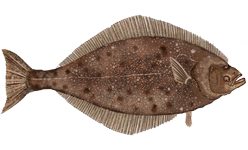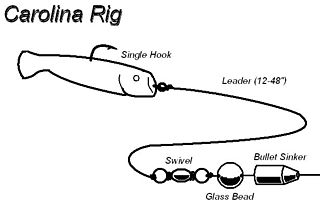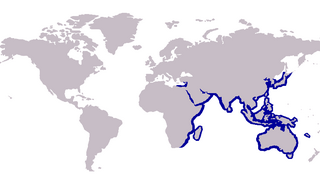
Fishing is the activity of trying to catch fish. Fish are often caught as wildlife from the natural environment, but may also be caught from stocked bodies of water such as ponds, canals, park wetlands and reservoirs. Fishing techniques include hand-gathering, spearing, netting, angling, shooting and trapping, as well as more destructive and often illegal techniques such as electrocution, blasting and poisoning.

Trolling is a method of fishing where one or more fishing lines, baited with lures or bait fish, are drawn through the water. This may be behind a moving boat, or by slowly winding the line in when fishing from a static position, or even sweeping the line from side-to-side, e.g. when fishing from a jetty. Trolling is used to catch pelagic fish such as salmon, mackerel and kingfish.

Angling is a fishing technique that uses a fish hook attached to a fishing line to tether individual fish in the mouth. The fishing line is usually manipulated via a fishing rod, although rodless techniques such as handlining also exist. Modern angling rods are usually fitted with a fishing reel that functions as a cranking device for storing, retrieving and releasing out the line, although Tenkara fishing and traditional cane pole fishing are two rod-angling methods that do not use any reel. The fish hook itself can be additionally weighted with a denser tackle called a sinker, and is typically dressed with an appetizing bait to attract and entice the fish into swallowing the hook, but sometimes an inedible fake/imitation bait with multiple attached hooks is used instead of a single hook with edible bait. Some type of bite indicator, such as a float, a bell or a quiver tip, is often used to relay underwater status of the hook to the surface and alert the angler of a fish's presence.

A speargun is a ranged underwater fishing device designed to launch a tethered spear or harpoon to impale fish or other marine animals and targets. Spearguns are used in sport fishing and underwater target shooting. The two basic types are pneumatic and elastic. Spear types come in a number of varieties including threaded, break-away and lined. Floats and buoys are common accessories when targeting larger fish.

Recreational fishing, also called sport fishing or game fishing, is fishing for leisure, exercise or competition. It can be contrasted with commercial fishing, which is professional fishing for profit; or subsistence fishing, which is fishing for survival and livelihood.

A fishing lure is a broad type of artificial angling baits that are replicas designed to mimic real prey animals and attract the attention of predatory fish, using appearances, flashy colors, bright reflections, movements, vibrations and/or loud noises to appeal to the fish's predation instinct and entice it into striking.

A fishing net is a net used for fishing. Some fishing nets are also called fish traps, for example fyke nets. Fishing nets are usually meshes formed by knotting a relatively thin thread. Early nets were woven from grasses, flaxes and other fibrous plant material. Later cotton was used. Modern nets are usually made of artificial polyamides like nylon, although nets of organic polyamides such as wool or silk thread were common until recently and are still used.
Bottom fishing, also called legering in the United Kingdom, is fishing of the bottom of a deep body of water such as lake or ocean, targeting groundfish such as sucker fish, bream, catfish and crappie. It is contrasted with conventional angling in that no float is used with the fishing line.

A fishing sinker or knoch is a weight used in conjunction with a fishing lure or hook to increase its rate of sink, anchoring ability, and/or casting distance. Fishing sinkers may be as small as 1 gram (0.035 oz) for applications in shallow water, and even smaller for fly fishing applications, or as large as several pounds or considerably more for deep sea fishing. They are formed into nearly innumerable shapes for diverse fishing applications. Environmental concerns surround the usage of lead and other materials in fishing sinkers.

Rock fishing is fishing from rocky outcrops into the sea. It is a popular pastime in Australia and New Zealand. It can be dangerous and many people have died. This may improve as more people who are rock fishing are beginning to wear life jackets.
The Texas rig is a fishing rig used for angling with soft plastic lures. It involves a bullet-shaped weight being threaded onto the fishing line first, that can be followed by a glass or plastic bead, and then the line is secured to a fish hook, usually an offset worm hook. The hook is then inserted into the head region of a worm lure and exits about 1⁄4 inch (6.4 mm) down the worm. The worm is then moved up the hook towards the shank and then rotated so that the worm is now "locked" on the shank. The point of the hook is then threaded back into the body of the worm to make the rig "weedless".

Hippoglossus stenolepis, the Pacific halibut, is a species of righteye flounder. This very large species of flatfish is native to the North Pacific and is fished by commercial fisheries, sport fishers, and subsistence fishers.

Fishing tackle is the equipment used by anglers when fishing. Almost any equipment or gear used in fishing can be called fishing tackle, examples being hooks, lines, baits/lures, rods, reels, floats, sinkers/feeders, nets, spears, gaffs and traps, as well as wires, snaps, beads, spoons, blades, spinners, clevises and tools that make it easy to tie knots.

In Britain and Ireland, coarse fishing refers to angling for rough fish, which are fish species traditionally considered undesirable as a food or game fish. Freshwater game fish are all salmonids — most particularly salmon, trout and char — so generally coarse fish are freshwater fish that are not salmonids. There is disagreement over whether grayling should be classified as a game fish or a coarse fish.

Soft plastic bait, commonly known as soft lure, soft plastics, plastic bait, worm lure or just worm, is any of a range of elastomer-based fishing lures termed so because of their flexible, flesh-like texture. Soft lures are available in a large range of colours, sizes and particularly shapes, and are typically impaled directly onto a fishing hook like an ordinary bait.

Fishing techniques are methods for catching fish. The term may also be applied to methods for catching other aquatic animals such as molluscs and edible marine invertebrates.
SandSinka is a lead-free fishing sinker made from biodegradable plastics that is filled with burley or sand or both. This sinker can be used as a float. A standard sinker. A sinker that allows extra weight to be on the line for casting, which will increase distance, then once the sinker is immersed in water it disperses the weight leaving you with a light line. It can also allow for burley to be added, which by design, is directly above the hook.
Lindy Legendary Fishing Tackle is an American producer of fishing tackle. Since its founding in 1968, the company's Lindy Rig has been used by over 40 million fishermen.

The Carolina rig is a fishing rig similar to the Texas rig, but with the sinker weight fixed above the hook instead of sliding down to it. The Carolina rig is suitable for beginning fishers, and this specific rig is designed to help fishermen catch bottom-feeding fish, particularly black bass. When placed in water, the lure attached to a Carolina rig will move in a circular motion. Bass are attracted to this movement and are therefore more likely to strike the lure. The Carolina rig also provides benefits for colder seasons, as the heavy weight on the rig allows the bait to reach deeper waters, where fish typically stay in winter months.

Smelt-whiting is the common name for various species of the family Sillaginidae. The Sillaginidae are distributed throughout the Indo-Pacific region, ranging from the west coast of Africa to Japan and Taiwan in the east, as well occupying as a number of small islands including New Caledonia in the Pacific Ocean. Well known members of this family include King George whiting, Japanese whiting, northern whiting, sand whiting and school whiting.

















